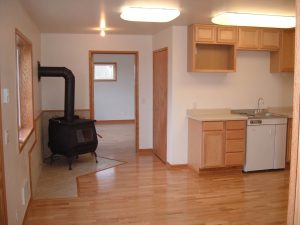Finishing the Inside of an Existing Pole Structure
There are literally millions of pole structures (aka post frame buildings or pole barns) in existence in the United States. Most of them were constructed without a thought as to future use, beyond their immediate need. Here is a story about one which actually did have some foresight!
 DEAR POLE BARN GURU: I have a customer who wants to finish the interior of a pole structure with a steel panel ceiling and drywall over framed walls. The building is 30’x40′ with 12′ ceilings, trusses on 8′ centers that are designed to carry the load of metal panels and blown insulation. The entire building, roof and walls are sheeted with 1/2″ osb. The roof is felted with perma felt and the walls are covered with Tyvek house wrap. The ridge is vented end to end and the 2′ overhangs are 12″ wide with vented steel soffit every third panel.
DEAR POLE BARN GURU: I have a customer who wants to finish the interior of a pole structure with a steel panel ceiling and drywall over framed walls. The building is 30’x40′ with 12′ ceilings, trusses on 8′ centers that are designed to carry the load of metal panels and blown insulation. The entire building, roof and walls are sheeted with 1/2″ osb. The roof is felted with perma felt and the walls are covered with Tyvek house wrap. The ridge is vented end to end and the 2′ overhangs are 12″ wide with vented steel soffit every third panel.
I plan to use 6″ fiberglass batting in the walls and blown-in insulation in the ceiling. The structure has 2 o.h. doors, 9’x10′, a walk in 3′ door and 3- 3’x3′ windows. It will be used for storage mainly with an open 15’x30′ man-cave area with a wood stove for heat when needed but not full time.
We are in southwest Iowa and I’d like some advice on proper moisture barrier if you’d be so kind.
Thank you, TOM in WOODBINE
DEAR TOM: Your customer has done things fairly well – which sadly doesn’t often happen.
The roof is in good shape for control of condensation under the roof steel. The OSB and felt should take care of this nicely. The attic may be under ventilated, with only having venting in every third soffit panel. Standard vented soffit usually will provide only about five square inches of intake per square foot of vent. With 160 square feet of sidewall soffit, your customer probably has about 800 square inches of intake (5.55 square feet), which might be adequate, but I sure would have been happier if he had all vented soffit panels.
Steel liner panel ceilings are always problematic –read more about them here.. https://www.hansenpolebuildings.com/2013/08/steel-liner-panels/
In the event your client is dead set upon a steel ceiling, make sure to do everything possible to reduce the humidity inside the building, so as to prevent condensation on the underside of the ceiling. If the concrete slab does not have a good vapor barrier under it – the floor should have a high quality sealant applied to the surface to reduce moisture coming through the floor. A test to determine if the vapor barrier is adequate or not is to leave a wrench on the floor overnight. When the wrench is removed in the morning, if there is a dark silhouette of the wrench on the floor, then moisture is passing through and needs to be controlled or eliminated.
On the walls the housewrap will keep moisture from the outside world out. Use unfaced fiberglass for the wall insulation, then cover all of the walls with 6 mil clear visqueen, read here:
(https://www.hansenpolebuildings.com/2013/07/moisture-barrier/).
The area to be heated with the wood stove is also going to be very prone as a high moisture area. The dry heat from the wood stove will draw excess moisture through the floor (again back to the floor), so additional ventilation may be needed in this area.
Good luck and let me know how it all turns out. Pictures are much appreciated, especially the man cave!
Mike the Pole Barn Guru








Hello Mr pole barn guru, I have a 48 x 60 truss system raised center aisle pole barn using 6 X 6 posts and 2 x 6 plates for truss supports. It was built by a national company. I want to add a master bath and bedroom where I used to have 3, 12 x 12 areas forming a total area of 12 x 36. This area is located on one of the wings. My problem is that I need to somehow brace the middle 6 x 6, on the outside wall and interior where the wing drops so that they will not interfere with doors and open room space. The center aisle is 24′ wide, with the wings being 12′ wide. Could I install some size and lenght header at the 2 x 6 plates ooms are attached? I’m also installing a new 2 x 6 wall running the 36′ lenght just 4′ inside toward to center of the barn, could I run a header from the outside plates to the top plate on my new wall? The 6 x 6 post on the outside wall could stay if it has too, but the inside post needs to come out at least from the floor to my ceiling height. Please advise. Thanks
It is possible to remove portions of columns, however the design of the columns, their support, headers and connections needs to be done by a Registered Design Professional (RDP – architect or engineer). My recommendation is to contract with the RDP who did the original plans for your building, as they are the Engineer of Record and will be most familiar with your project. Other issues may exist as well – especially if your building was not originally designed to be a residence. Most often these issues are excessive deflection which can result in cracking of drywall and other interior finishes.